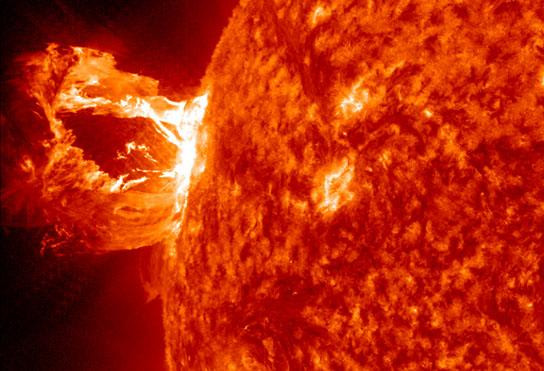Solar storms implicated in incidences of rheumatoid arthritis and giant cell arteritis

Turns out, solar storms can affect more than just power grids and satellites. A "highly significant" relationship has been established between periodic solar flares and incidences of autoimmune diseases.
For instance, the rheumatoid arthritis (RA) and giant cell arteritis (GCA) in medical data are clearly in a periodic concert with the cycle of magnetic activity of the sun. Confirming, that a causal link can help develop therapies to counteract causal agents controlled by geomagnetic activity in susceptible individuals, besides relocating to lower latitudes.
Conversations between Simon Wing, a Johns Hopkins University physicist and first author of the paper, and his wife, Lisa Rider, deputy unit chief of the Environmental Autoimmunity Group at the National Institute of Environmental Health Sciences and a co-author resulted in the study.
Rider spotted data from the Mayo Clinic in Rochester showing that cases of RA and GCA followed close to 10-year cycles. "That got me curious," Wing recalled. "Only a few things in nature have a periodicity of about 10-11 years and the solar cycle is one of them."
Wing teamed with physicist Jay Johnson of the US Department of Energy's Princeton Plasma Physics Laboratory, and tracked the incidence of RA and GCA cases compiled by Mayo Clinic researchers to find the correlation.
The results suggested "more than a coincidental connection", said Eric Matteson, chair of the division of rheumatology at the Mayo Clinic, and a co-author.
Solar cycle
The solar cycle can affect space weather near Earth. At the solar maximum, coronal mass ejections from the sun send tonnes of magnetic and electrically charged plasma gas into Earth's magnetosphere.
During the declining phase of the solar maximum, high-speed plasma streams flow from the sun. These produce enhanced geomagnetic activity at high Earth latitudes.
The research, which tracked correlations of the diseases with both geomagnetic activity and extreme ultraviolet (EUV) solar radiation, compared the data with indices of EUV radiation for the years 1950 through 2007 and geomagnetic activity from 1966 through 2007.
Correlations proved to be strongest between the diseases and geomagnetic activity. GCA incidence -- defined as the number of new cases per capita per year in the country -- regularly peaked within one year of the most intense geomagnetic activity, while RA incidence fell to a minimum within one year of the least intense activity.
Correlations with the EUV indices were not as robust and showed a significantly longer response time.
Autoimmune diseases
RA results in painful swelling and deformity of joints caused when immune cells incorrectly identify and attack healthy cells as foreign bodies.
There are over 300,000 people in the UK who are suffering from the disorder where inflammation wears down cartilage and causes the bones to rub against each other.
In GCA which affects older people, the immune attack results in inflammation of the wall of arteries, leading to headaches, jaw pain, vision problems and even blindness in severe cases.
The findings were consistent with previous studies of the geographic distribution of RA cases in the United States. Greater incidence of the disease was seen in sections of the country more likely to be affected by geomagnetic activity.
The authors suggest one of the causal pathways could be related to reduced production of the hormone melatonin, an anti-inflammatory mediator with immune-enhancing effects, and increased formation of free radicals in susceptible individuals.
Boosting this association was a study of 142 electrical power workers with melatonin reduced by 21% on days with increased geomagnetic activity.
A more broad-based study including other locations and autoimmune diseases could firm up the link to solar cycle.
The results are published in BMJ Open.
© Copyright IBTimes 2025. All rights reserved.





















